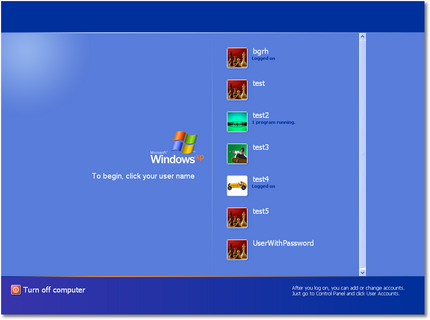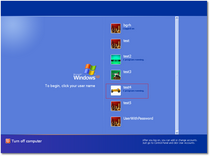Remko Weijnen's Blog (Remko's Blog)
About Virtualization, VDI, SBC, Application Compatibility and anything else I feel like
I think many of you have got experience with multiple Terminal Server Sessions in windows XP, also called Fast User Switching (FUS). Let’s get inside this cool feature.
How does FUS work? Each session has its own winlogon.exe. It draws the same interface which looks like the screenshot below:
1) When the current session is empty (no user is logged in), and you clicking on a user name, the system just logs you on to the current session. This case is very clear.
2) If you click on an already logged in user, you are connected to the target user session using the WinStationConnect API. It’s prototype is
1 2 3 4 5 | function WinStationConnectA(hServer: Handle; SessionID: DWORD; TargetSessionID: DWORD; pPassword: PChar; bWait: Boolean): Boolean; stdcall; external 'winsta.dll'; function WinStationConnectW(hServer: Handle; SessionID: DWORD; TargetSessionID: DWORD; pPassword: PWideChar; bWait: Boolean): Boolean; stdcall; external 'winsta.dll'; |
The current session is just disconnected (if it contains logged on user) or even eliminated (if it doesn’t contain a logged on user and if its not session number 0, which is never disposed).
3) But what happens when you click on a user other than yourself and you are already logged into the current session? Visually it looks almost the same – but look, there is a quick blank switch (you may not notice this as it disappears very quickly). This is a session disconnect and re-connect:
So what is happening? After verifying your credentials, msgina.dll starts a Credential Server, and disconnects the current session from the console. Because the console session is an auto-reconnected session (if you disconnect it, you’ll get a new session attached to the console (Terminal Server has even a “hardcode” in termsrv.dll to reconnect console session faster, if the current gina is msgina.dll)), a new session will be created and attached to the console. Msgina.dll perfoms some checks on startup: if it’s attached to the console session, and the Credential Server is running, it will read the credentials, and perform the login as if the credentials were typed manually.
But how we can use this programmatically? Msgina.dll has an undocumented, exported, function named ShellStartCredentialServer. It’s exported from msgina.dll by ordinal #23.
It’s full prototype is
1 | function ShellStartCredentialServer (UserName : PWideChar; Domain : PWideChar; Password : PWideChar; Timeout : DWORD) : DWORD; stdcall; external 'msgina.dll' index 23 |
The function doesn’t validate anything; it just packs the data, writes it to a pipe and disconnects the console session. However, if the credentials are invalid, you will not get FUS working, so it is a good idea to validate them before sending. The domain parameter is ignored (it seems that FUS was initially designed to work with domain users as well, however this support was apparently dropped on some stage). If you pass valid credentials data, but the user is already logged on, you will just switch to this session. So you can use this function whenever you need to switch the console. You can even call this function from an RDP session but it will still affect the console session only.
This function will fail if the Welcome screen is disabled; in that case you’ll just get your session disconnected and locked. The caller is required to have SE_TCB_NAME privilege (“Act as part of the operating system”) enabled. Actually, this is not enough since the default security of the registry hive HKLM\SOFTWARE\Microsoft\Windows NT\CurrentVersion\Winlogon\Credentials allows read and write access to system only.
In the next part I’ll show you how to create your own implementation of the Credential Server.
Profile
Top Posts
- Query Active Directory from Excel
- RNS 510 Startup Logo–My thoughts
- Adding a hidden Exchange mailbox to Outlook
- How rdp passwords are encrypted
- Get Actual CPU Clock Speed with PowerShell
- ClickOnce Applications in Enterprise Environments
- VW RNS 510 Navigation Startup Pictures
- Unattended Installation of IBM System i Access for Windows
- Reading physical memory size from the registry
- Show Client IP Address when using NetScaler as a Reverse Proxy
Recent Comments
Featured Downloads
- AClientFix (13595 downloads )
- AddPrinter2.zip (12854 downloads )
- AdProps (12379 downloads )
- AdSample1 (11432 downloads )
- AMD Radeon Crimson ReLive (25958 downloads )
- Atheros Driver (34019 downloads )
- AutoLogonXP 1.0 (11404 downloads )
- CDZA (9560 downloads )
- ChDrvLetter.zip (11217 downloads )
- ChDrvLetter.zip (14356 downloads )
Blogroll
- Andrew Morgan
- Arnout’s blog
- Assa’s Blog
- Barry Schiffer
- Delphi Praxis
- Ingmar Verheij
- Jedi Api Blog
- Jedi API Library
- Jeroen Tielen
- Kees Baggerman
Categories
- .NET (4)
- Active Directory (28)
- Altiris (36)
- App-V (1)
- Apple (5)
- Application Compatibility (11)
- Automotive (5)
- AWS (1)
- BootCamp (1)
- C# (6)
- C++ (2)
- Citrix (87)
- Delphi (61)
- Embedded (4)
- Exchange (16)
- General (71)
- iPhone (5)
- Java (8)
- Linux (1)
- Lync (2)
- NetScaler (1)
- Oracle (4)
- Other (1)
- Packaging (19)
- PowerShell (56)
- Programming (79)
- Quest (1)
- RES (7)
- script (22)
- ShareFile (1)
- SQL Server (10)
- Strange Error (3)
- Terminal Server (68)
- ThinApp (3)
- ThinKiosk (1)
- Ubuntu (1)
- Unattended Installation (19)
- Uncategorized (51)
- UWP (2)
- Vista (37)
- Visual Studio (1)
- VMWare (26)
- Windows 10 (2)
- Windows 2003 (30)
- Windows 2008 (37)
- Windows 2008 R2 (16)
- Windows 2012 (2)
- Windows 7 (30)
- Windows 8 (4)
- Windows Internals (12)
- Windows XP (16)
Archives
- February 2023 (1)
- October 2022 (3)
- July 2022 (1)
- June 2022 (2)
- October 2019 (1)
- March 2018 (1)
- January 2018 (4)
- December 2017 (3)
- April 2017 (1)
- March 2017 (5)
- February 2017 (4)
- May 2016 (3)
- March 2016 (1)
- October 2015 (2)
- September 2015 (1)
- January 2015 (1)
- August 2014 (1)
- July 2014 (8)
- May 2014 (1)
- November 2013 (1)
- October 2013 (2)
- September 2013 (3)
- August 2013 (4)
- June 2013 (2)
- May 2013 (3)
- April 2013 (5)
- March 2013 (5)
- February 2013 (1)
- January 2013 (5)
- December 2012 (9)
- November 2012 (3)
- October 2012 (3)
- August 2012 (4)
- July 2012 (2)
- June 2012 (1)
- May 2012 (6)
- March 2012 (13)
- February 2012 (12)
- January 2012 (9)
- December 2011 (9)
- November 2011 (4)
- October 2011 (5)
- September 2011 (10)
- August 2011 (10)
- July 2011 (2)
- June 2011 (8)
- May 2011 (12)
- April 2011 (4)
- March 2011 (14)
- February 2011 (8)
- January 2011 (32)
- December 2010 (23)
- November 2010 (19)
- October 2010 (10)
- September 2010 (6)
- August 2010 (1)
- July 2010 (1)
- June 2010 (6)
- March 2010 (7)
- February 2010 (3)
- December 2009 (3)
- November 2009 (11)
- September 2009 (2)
- July 2009 (1)
- June 2009 (5)
- May 2009 (1)
- April 2009 (2)
- March 2009 (3)
- February 2009 (6)
- January 2009 (3)
- December 2008 (8)
- November 2008 (5)
- October 2008 (3)
- September 2008 (3)
- August 2008 (3)
- June 2008 (6)
- May 2008 (2)
- April 2008 (3)
- March 2008 (5)
- January 2008 (3)
- December 2007 (3)
- November 2007 (13)
- October 2007 (10)











8 Responses for "Executing a Fast User Switch programmatically – part 1"
Hi
very good internal stuff. That’s fantastic. I’m curious about more articles.
[…] Part1 […]
Hey Remko, are you aware of the awesome Super Fast User Switcher powertoy Microsoft had for XP but which they pulled later? Is such a thing possible for Vista/Windows 7?
Have you ever found a way to get this working if there’s no welcome screen? I do need to log in domain users, and it behaves just as you described it would if there’s no welcome screen.
You’ll need to have a custom gina for that. You can use FMLogin freeware gina(http://www.frontmotion.com/FMLogin/), it allows you to have a fast user switching on XP computer running within domain.
Thanks a lot for your post.
For sate “1) When the current session is empty” that you said “This case is very clear.” how we can use this programmatically? What is the API or chain APIs that I can login interactively when there is no any login session. For example after system restart and before any login (I want to use API in my Windows Service to login into Win XP)
Hello Naser,
You can use this program to login interactively if there is no any login session as well. You can also just use ShellStartCredentialServer and disconnect the console.
Thank you for extremely valuable info. But how can I do the same on Vista and later systems?
Leave a reply